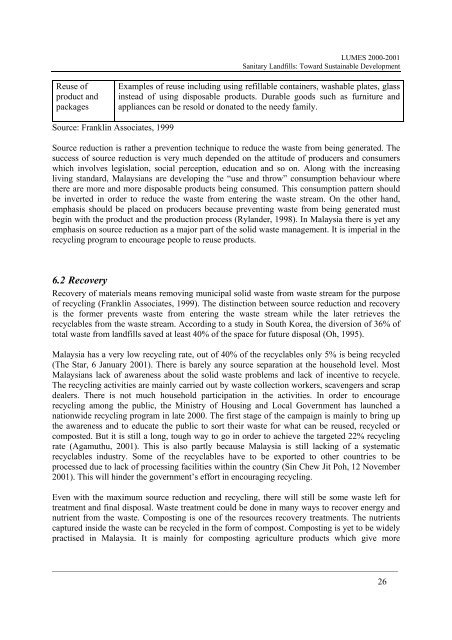Sanitary Landfills: Toward Sustainable Development - lumes
Sanitary Landfills: Toward Sustainable Development - lumes
Sanitary Landfills: Toward Sustainable Development - lumes
You also want an ePaper? Increase the reach of your titles
YUMPU automatically turns print PDFs into web optimized ePapers that Google loves.
Reuse of<br />
product and<br />
packages<br />
Source: Franklin Associates, 1999<br />
LUMES 2000-2001<br />
<strong>Sanitary</strong> <strong>Landfills</strong>: <strong>Toward</strong> <strong>Sustainable</strong> <strong>Development</strong><br />
Examples of reuse including using refillable containers, washable plates, glass<br />
instead of using disposable products. Durable goods such as furniture and<br />
appliances can be resold or donated to the needy family.<br />
Source reduction is rather a prevention technique to reduce the waste from being generated. The<br />
success of source reduction is very much depended on the attitude of producers and consumers<br />
which involves legislation, social perception, education and so on. Along with the increasing<br />
living standard, Malaysians are developing the “use and throw” consumption behaviour where<br />
there are more and more disposable products being consumed. This consumption pattern should<br />
be inverted in order to reduce the waste from entering the waste stream. On the other hand,<br />
emphasis should be placed on producers because preventing waste from being generated must<br />
begin with the product and the production process (Rylander, 1998). In Malaysia there is yet any<br />
emphasis on source reduction as a major part of the solid waste management. It is imperial in the<br />
recycling program to encourage people to reuse products.<br />
6.2 Recovery<br />
Recovery of materials means removing municipal solid waste from waste stream for the purpose<br />
of recycling (Franklin Associates, 1999). The distinction between source reduction and recovery<br />
is the former prevents waste from entering the waste stream while the later retrieves the<br />
recyclables from the waste stream. According to a study in South Korea, the diversion of 36% of<br />
total waste from landfills saved at least 40% of the space for future disposal (Oh, 1995).<br />
Malaysia has a very low recycling rate, out of 40% of the recyclables only 5% is being recycled<br />
(The Star, 6 January 2001). There is barely any source separation at the household level. Most<br />
Malaysians lack of awareness about the solid waste problems and lack of incentive to recycle.<br />
The recycling activities are mainly carried out by waste collection workers, scavengers and scrap<br />
dealers. There is not much household participation in the activities. In order to encourage<br />
recycling among the public, the Ministry of Housing and Local Government has launched a<br />
nationwide recycling program in late 2000. The first stage of the campaign is mainly to bring up<br />
the awareness and to educate the public to sort their waste for what can be reused, recycled or<br />
composted. But it is still a long, tough way to go in order to achieve the targeted 22% recycling<br />
rate (Agamuthu, 2001). This is also partly because Malaysia is still lacking of a systematic<br />
recyclables industry. Some of the recyclables have to be exported to other countries to be<br />
processed due to lack of processing facilities within the country (Sin Chew Jit Poh, 12 November<br />
2001). This will hinder the government’s effort in encouraging recycling.<br />
Even with the maximum source reduction and recycling, there will still be some waste left for<br />
treatment and final disposal. Waste treatment could be done in many ways to recover energy and<br />
nutrient from the waste. Composting is one of the resources recovery treatments. The nutrients<br />
captured inside the waste can be recycled in the form of compost. Composting is yet to be widely<br />
practised in Malaysia. It is mainly for composting agriculture products which give more<br />
______________________________________________________________________________<br />
26

















